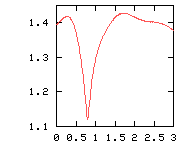
Head-on collision of two Lamb dipoles
Details on the computation and presentation
Initialisation
Dipoles: velocity: U = 2; maximum initial vorticity 22.1
radius: a = 1
angle of dipole axis with X-axis: 0 and 180 degrees
positions: (-1.8,0) and (+1.8,0)
Computation: domain: X = (-3, ..., 3), Y = (-6, ..., 6) computed
X = (-4, ..., 4), Y = (-4, ..., 6) shown
no. of grid points from wall to wall: (129, 257)
boundary conditions: stress-free along all walls
(for this case similar to periodic conditions
due to the symmetry of the problem)
standard Arakawa scheme used
no rotation effects included
no bottom topography
viscosity: nu = 10^-3 (i.e. Re=1000 at T=0)
time step: dt = 0.01
final time: T = 2 (shown; computed until 3)
Tracers: along vorticity contours (i.e. along streamlines)
of both Lamb dipoles at vorticity levels: 0.1, 6.0,
12.0, 18.0; and a single tracers at each extremum
Some results
 Courant number CFL vs. time
Courant number CFL vs. time
The Courant number CFL is a measure for the maximum velocity
in the domain, which is lowest at the time of the collision.
Due to the viscosity, the overall velocity decreases in time,
though that cannot be seen clearly in this graph;
see for instance the details on
Lamb dipole in a domain with stress-free walls.
Note
The tracer lines are not always smooth. The reason for this
is that the representation of the lines by points is not always
accurate enough. But since these tracers only passively follow
the flow, this has no effect on the computations.
It needs repair, though.
<=== Head-on collision of two Lamb dipoles
 Jos van Geffen --
Home |
Site Map |
Contact Me
Jos van Geffen --
Home |
Site Map |
Contact Me
last modified: 26 May 2001
 Courant number CFL vs. time
Courant number CFL vs. time 
 Jos van Geffen
Jos van Geffen